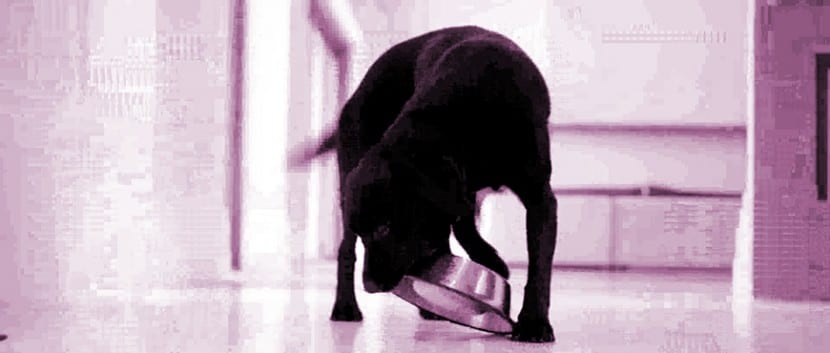
There is a well-known phrase that tells us that we are what we eat. If this is truly the case, we should ask ourselves this question after buying your sack of food at the usual supermarket and buying the cheapest brand. If a 10 kg bag costs us 20 eu, we should ask ourselves at least, how is it possible that my dog's food costs so cheap and if it suits him.
Today I will analyze the situation of the dog food industry, what they are made of, what is their quality, what is the ideal diet for a dog or how it affects our dog to eat such cheap food. And the answers I promise will be surprising to say the least. I leave you with this article called, Dogs and food stress.
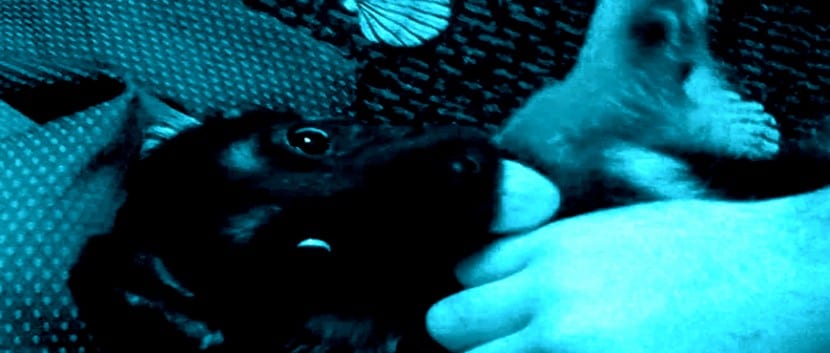
Humanizing our dogs.
Humans we tend to project onto our dogs by humanizing them. That's not something new. And it is not that human beings do it only with dogs and cats, but rather that we tend to do it with objects or places. This is called Anthropomorphism, and it is one of the biggest causes of stress in our animals, at levels we can only imagine. And many people don't even imagine it.
Every day I have to confront people in my work who believe that by talking to the dog, the dog understands them. It is difficult to make them understand that not only do they not understand well the message we send them, but that we can confuse and harass them, blocking them.
And what's wrong with dyeing my dog's hair, putting a jacket and a cap on him, or letting him get on the couch?
Dogs need the affection of their human families, since being animals that live and move in herds, physical contact, social acceptance, or the rites of that herd are their own hallmark. The dog needs to feel respected, loved, safe within his home.
Our responsibility.
It is clear that we, as the people responsible for our dog that we are, want the dog to feel as I have described in the previous paragraph, loved, accepted and respected, and our way of showing it is 100% human, buying things, giving to eat trinkets, making him handsome with clothes and colors that are not his own, when we do not realize that the dog, as a dog that he is, all he wants is the contact of his family. The human usually does it as a sign that he cares about the welfare of his dog, however, this type of treatment of the animal subjects it to more stress than to anything else for various reasons.
The first is that by humanizing it, we tend to stop setting limits, regardless of the canine psychology, and then use coercive methods within the corrections we make to their behavior, which is marked in this case by the treatment we give them.
It is not bad to treat the dog like someone in your family, as long as that does not mean not giving it an adequate education for a dog that lives with a human family, in a human home, and in a humane society. For this we will have to raise it with rules and limits that help it to be comfortable and at the same time to make everyone comfortable with it. And this means not having the dog spoiled, letting him do what he wants and excusing him for his behavior, to justify it later before the impotence of not knowing how to act. In a previous post, in Educating on an emotional level: The Stress that humans cause and its subsequent termination in Educating on an emotional level: The Stress that humans cause II, I talk about this topic in a more extensive way.
Another issue to take into account is that when dressing or dyeing them, We can change the body gestures of our dog and confuse him, as well as other members of his species, which can lead to unwanted situations.
Another way we have to humanize our dog is from his diet. And this is the most serious.
One of my best friends, let's call her Ana, It is vegetarian. Ana has a lot of experience with dogs, since she has been in a shelter for several years, managing foster care and others, and besides studying veterinary medicine. He is someone I would rate as having a lot of experience with dogs. However, lYou've been wanting to put your dog on a plant-based diet for years momo. You've tried everything, even looking for brand-name feed that is just plant-based, or made with rice flours. She thinks she's doing the right thing, Ya que believe that the correct diet of your dog it can be based on carbohydrates and vegetable protein and fats just like her, forgetting something that is vital for the correct feeding of your dog. The dog is a carnivore.
And this is a reality.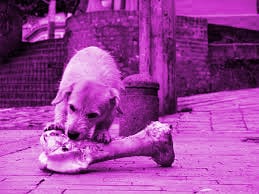
The dog is a carnivorous animal.
And not that I say it. It is so for several reasons. Until recently it was believed that dogs were moving further and further away from their wolf ancestors, however the Smithsonian Institute in a recent study concluded that dogs and wolves are 99% identical at the genetic level. So much so, that they have re-classified the dog as a species, from Canis Familiaris to Canis Lupus Familiaris.
Dogs are carnivores for several reasons on a physical level:
- Dogs do not produce amylase. The amylase es an enzyme present in the mouth of most herbivores and omnivores necessary to break down the carbohydrates present in their food. They chew their food a lot, salivate, and there in that saliva is the amylase. Carnivores do NOT produce amylaseThey do not need it because their diet is NOT based on cereals or grains. If you don't eat carbohydrates Why produce amylase?
- Short and acid digestive tract. Dogs have a carnivore's own digestive tract, which means that it is no more than 3 times its size, and that it has a PH of 1-2. This is so because the meat of the prey needs to be degraded. This also helps them digest spoiled or rotten meat, since our dogs were scavengers as well as hunters.. On the other hand, herbivores have a digestive tract up to 12 times its size and with a PH of 5, ideal for being able to digest grains and vegetables..
- Sharp teeth and vertical jaw movement. Dogs do not move their mouths like a herbivore. The herbivores make circular and rotating movements of the jaw to be able to grind and shred the grains and vegetables of which their diet is composed. Dogs only move their mouth vertically since they do not chew, grasp, grind and swallow. That simple.
According to the great canine nutritionist, Carlos Alberto Gutierrezin his book "The Scandalous Truths About Dog Food":
Continuously feeding a carnivore carbohydrates forces their pancreas to produce more insulin (the hormone that introduces sugar into cells). The pancreas of a carnivore works much less than that of omnivores and herbivores because it is not used to large amounts of carbohydrates.
This overproduction of insulin has several physical effects on the dog, among which hypoglycemia or low blood sugar levels can be found.
Now that it is clear that the dog is a carnivore and why is it a carnivore, let's ask ourselves, What does a carnivore eat?
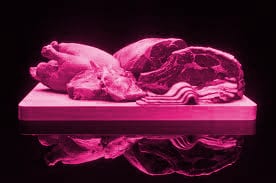
Eating like a carnivore.
Once we have defined a carnivore, let's see what and why. Quoting again Carlos Alberto Gutierrez:
Especially prey, a bird, a rabbit, a decomposing corpse, and when they hunt in a herd, then some reindeer or large animals, many times injured or that have left the group for different reasons, illness, old age ...
Modern dogs of all races, including yours, have very few years on the face of the earth, they have been manipulations of man. To give you an idea, these breeds are a few hundred years old and come from the wild dogs that emerged alongside modern man about 80,000 years ago. These wild dogs in turn are directly descended from the million-year-old wolf.
Evolutionary changes do not occur in a few hundred years but in thousands. As I told you, your dog has only been with us for a few centuries. Nothing has changed from his cousin and predecessor: the wild dog and the wolf, except the appearance.
Dogs eat mostly animal protein. Imagine for a moment that a Protein is like a chain, and the links that form it are called amino acids. These amino acids are not the same in plant proteins as in animal ones.
Dogs need 22 essential amino acids for their life. It, through its liver, is capable of producing 12 of these amino acids, however 10 of them, you must get them from your diet. And not those amino acids, like taurine, lysine, arginine, or threonine, are not found in the amino acid chains of plant proteins. Therefore, here we clearly see that our dog needs meat, fish or eggs to get what it needs to live.
But, what is my dog's feed made of? ... this is where the drama begins.
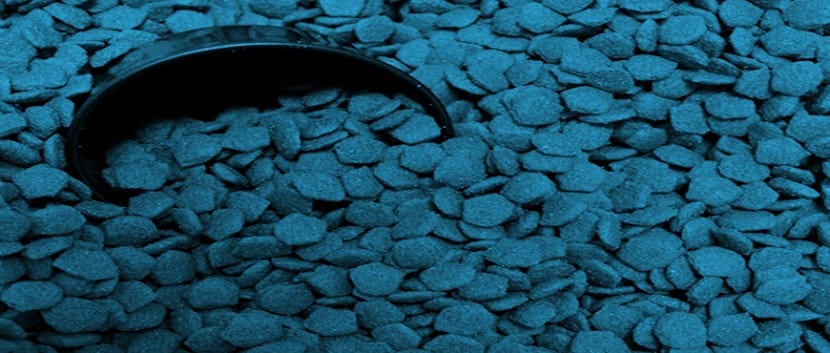
To be happy, I want a feed factory.
Most feed is composed from high levels of carbohydrates from cheap grains and cereals, as well as by-products of the human food industry. Here in Spain, there are two food regulations, one that applies to human food and the other that applies to animal food. Most of the companies that manufacture feed are large food multinationals, which, in order to make the most of the resources of their companies, convert the waste from human food factories into gold, by obtaining, through these, feed for dogs. and cats, that with the convenient marketing campaign they make us pay up to 90 eu for 15 kilos of dry food in balls for our pets. I repeat it again, they turn waste into gold.
What actually takes the feed.
According to Eva Martin, in your article, Healthy Nutrition for our pets? from your page, Alimentacioncanina.com:
The protein in dry foods (feed) comes from a variety of sources. When cattle, pigs, chickens, lambs and other animals are slaughtered, muscle tissue is trimmed from the carcass for human consumption, along with the few organs that people like to eat, such as tongues and corns.
However, about 50% of all foods of animal origin are not used in human foods. What is left of the carcass - heads, legs, bones, blood, intestines, lungs, spleen, liver, ligaments, fat trimmings, unborn babies, and elsewhere generally do not consume beings humans, other products that are used in pet food, and animal food, are fertilizers, industrial lubricants, soaps, rubber and other products. These "other parts" are known as "By-products". The by-products are used in poultry and livestock feed, as well as pet food.
The nutritional quality of by-products, foods, and their digestion can vary from batch to batch. James Morris and Rogers Quinton, of the University of California at Davis Veterinary School, state that, "pet food ingredients" are generally the by-products of the meat, poultry and fish industries, with the potential for a wide variation in nutrient composition. Claims for the nutritional adequacy of pet food based on the American Association of Current Feed Control Officials (AAFCO) Nutrient Subsidy "Profiles" do not guarantee nutritional adequacy, not until ingredients are analyzed and values of bioavailability are incorporated.
This clearly means that it is not only important that the dog has the animal protein required by its diet, but also that this protein has to have a certain quality to obtain good nutritional levels. The example that sets us the White Book of the Orijen brand, from Champion Foods, I find it very illustrative:
Let's say we have a pair of old leather boots… some used motor oil… and a tablespoon of sawdust. Now, we crush them ... we mix them all ... and send that potingue to a laboratory test ... for analysis.
The result?
This potpourri of waste contains ...
Protein 32%
Fat 18%
Fiber 3%
Now if you just look at the "naked figures" ... the numbers make this unworthy mix look beyond good ... in fact, as good as any quality dog food. It's not exactly something you want to feed your dog. Any questions about how easily they can fool you?
The quality of the protein source will mark another key factor in the dog's diet, its digestibility. According Champion Foods White Paper:
Protein digestibility is a key quality measure.
After all, what benefit is there to have a food made with higher quality proteins if they cannot be easily digested?
Meat proteins are the best option - they are easily digested and contain essential amino acids for dogs and cats.
To better understand protein digestibility, it is important to note that digestion itself is the gradual breakdown of food into components small enough to pass through the intestinal walls and into the bloodstream.
• A food with a high protein digestibility is one that can be broken down into smaller, easily absorbed components more easily and quickly than others.
• Protein ingredients that meet both amino acid requirements and high digestibility almost always come from animal sources.
• In the short digestive systems of cats and dogs, plant proteins are much less digestive than meat proteins.
• High levels of trypsin-inhibiting legumes can cause reductions in protein and amino acid digestibility (up to 50%) in rats and pigs.
Similarly, the presence of high levels of tannins in cereals, such as sorghum, and legumes, can cause protein and amino acid digestibility to be significantly reduced (up to 23%) in rats, poultry and pigs.
We have to remember that there is all a food industry behind the concept of dog food, an industry that moves billions of euros a year around the world. This industry tells us that the ideal diet for a dog is based on cereals and vegetables for a simple reason: it is easier to synthesize the food in balls of feed for our dogs in grains, cereals and vegetables than meat and fish. This means that our dog's diet is based on a food that barely feeds him, simply due to an industry convection that, through a good marketing campaign, has us convinced that it is the best for them.
It is totally the opposite. I think = Poison for our dog.
Drawing conclusions.
There are a couple of conclusions that we can draw from this short but intense analysis of the situation:
- The Dog is Carnivore and needs animal protein.
- I think in balls (or cans of meat) do not have the proteins and fats that help you obtain the 10 essential amino acids for your diet such as arginine, lysine or tryptophan.
The dog gets everything in this life from us. If he goes out, it is because we take him out, if he drinks it is because we give him water, and if he eats it is because we feed him. If there is a deficiency in your diet, we are the ones who have the responsibility to correct it, since he cannot. However, he is the one who suffers it.
When the dog notices that the feed does not feed him, that something is missing, not being able to do anything by himself, since he does not have the possibility of going hunting, he will begin to suffer stress, which at first will manifest itself in a timely manner, leading him to maintain the situation or to worsen (it grows without what is necessary to grow on your diet or spend more energy than you take in) to become a source of serious stress, from which all kinds of compulsive behaviors and Distres can arise, that can lead in various ways, from diseases related to your psychoneuroimmune system, even episodes of separation with his family, they do not understand what happens to the dog.
The maxim of this situation is simple seen from a physical point of view of the biochemistry of the animal's anatomy: If the dog needs protein of animal origin to obtain, for example, tryptophan, which is the amino acid in charge of producing serotonin, which is very important for the correct rest of the animal as it is the promoter of sleep, and it does not obtain it from its diet, it will become stressed. In a series of previous articles, I take an in-depth look at stress in our dogs, starting at the entrance Educating on an emotional level: Stress and ending in Educating on an emotional level: The Stress that humans cause II. In this series of articles you will understand how stress affects your dog.
Let's recap.
The dog is a carnivorous animal, which despite being fully integrated into human society, is not omnivorous like us. This makes Diets based on industrial feed obtained from raw materials of very low quality (so low that we would not eat it ourselves), represent an inexhaustible source of problems for our pets, from physical illnesses, to accumulating stress around food, resulting in a dog with a multitude of compulsive attitudes and behaviors that we neither understand nor are able to resolve.
Changing the diet of our dogs is vital, and you will ask yourself, like Antonio? ...
Well, Antonio is going to tell you.
Don't miss the next canine feeding guides from Mundo perros and his recipe book.
And I'm also going to tell you the story of the origin and evolution of industrial dog foods based on by-products of the human food industry. So that you get angry and know why.
Greetings and thank you very much for reading me. Take care of your dogs.
The truth is that I go crazy with all this. We are quite deceived when it comes to feeding our dogs. I had no idea about all this. Thank you!!!
MY bitch consumes Barf and has never had a digestive problem although sometimes she asks that her diet be varied with another type of meat, other flavors but nothing else